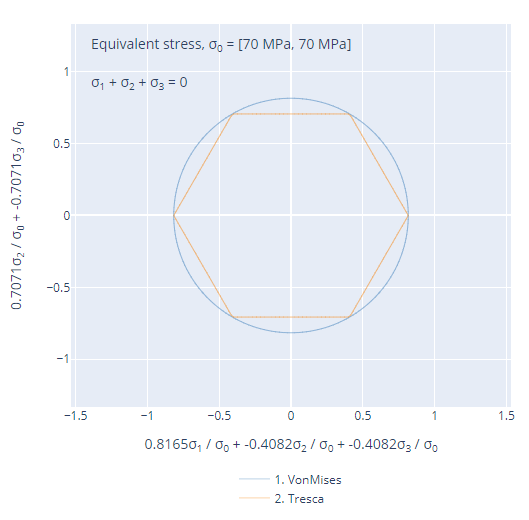formable provides tools for formability analysis in materials science.
pip install formable
To support showing visualisations within a Jupyter notebook, you will also need to make sure Plotly is set up to work within the notebook environment:
pip install "notebook>=5.3" "ipywidgets>=7.2"
The response of a material to a load is represented by the LoadResponse class. Use the following code snippet create a LoadResponse, where the arguments passed represent incremental data (i.e. data for each of the "steps" in the loading):
from formable import LoadResponse
load_response = LoadResponse(true_stress=true_stress, equivalent_strain=equivalent_strain)true_stress and equivalent_strain are Numpy arrays of shapes (N, 3, 3) and (N,), respectively, for N increments within the load response.
A collection of load responses that contain the same incremental data are represented by the LoadResponseSet class:
from formable import LoadResponse, LoadResponseSet
all_responses = [LoadResponse(...), LoadResponse(...), ...]
load_set = LoadResponseSet(all_responses)A number of yield functions as defined in the literature can be fitted and visualised. As an example, let's visualise the difference between the Von Mises and the Tresca yield criteria:
from formable.yielding.yield_functions import YieldFunction, VonMises, Tresca
von_mises = VonMises(equivalent_stress=70e6)
tresca = Tresca(equivalent_stress=70e6)
YieldFunction.compare_3D([von_mises, tresca])If run within a Jupyter environment, this code snippet will generated a 3D visualisation of the yield surfaces in principal stress space:
To look at a single plane within principal stress space, we can do this:
YieldFunction.compare_2D([von_mises, tresca], plane=[0, 0, 1])which generates a figure like this:
We can choose any plane that intercepts the origin. For instance, we can also look at the π-plane (σ1 = σ2 = σ3):
YieldFunction.compare_2D([von_mises, tresca], plane=[1, 1, 1])which generates a figure like this:
Using experimental or simulated yielding tests, we can fit yield functions to the results. Consider a LoadResponseSet object that has a sufficiently large number of increments of true_stress and equivalent_strain data to enable such a fit. Using the Barlat "Yld2000-2D" anisotropic yield function as an example, we can perform a fit:
from formable import LoadResponse, LoadResponseSet
from formable.yielding import YieldPointCriteria
# First generate a LoadResponseSet, using the results from experiment/simulation:
all_responses = [LoadResponse(...), LoadResponse(...), ...]
load_set = LoadResponseSet(all_responses)
# Then define a yield point criterion:
yield_point = YieldPointCriteria('equivalent_strain', 1e-3)
# Now calculate yield stresses according to the yield point criteria:
load_set.calculate_yield_stresses(yield_point)
# Now we can fit to the resulting yield stresses:
load_set.fit_yield_function('Barlat_Yld2000_2D', equivalent_stress=70e6)We can specify which of the yield function parameters we would like to fit, and which should remain fixed. We can also pass initial values to the fitting procedure. A least squares fit is employed to fit yield functions in formable.
To fix a parameter during the fit, just pass it as a keyword argument to the fit_yield_function method, as we did in the above example, where we fixed the equivalent_stress parameter. To pass initial values for some of the parameters, we can pass a initial_params dictionary:
load_set.fit_yield_function('Barlat_Yld2000_2D', initial_params={'a1': 1.4})We can see the available parameters of a given yield function by using the PARAMETERS attribute of a YieldFunction class:
from formable.yielding.yield_functions import Barlat_Yld2000_2D
print(Barlat_Yld2000_2D.PARAMETERS)which prints:
['a1',
'a2',
'a3',
'a4',
'a5',
'a6',
'a7',
'a8',
'equivalent_stress',
'exponent']
Alternatively, if we have created a yield function object (from a fitting procedure, or directly), we can use the get_parameters method to get the parameters and their values:
print(von_mises.get_parameters())which prints:
{'equivalent_stress': 70000000.0}
Once a yield function has been fit to a load set, we can visualise the fitted yield function like this:
load_set.show_yield_functions_3D()or, in a similar way to above, we can visualise the fitted yield functions in a given principal stress plane, using:
load_set.show_yield_functions_2D(plane=[0, 0, 1])

